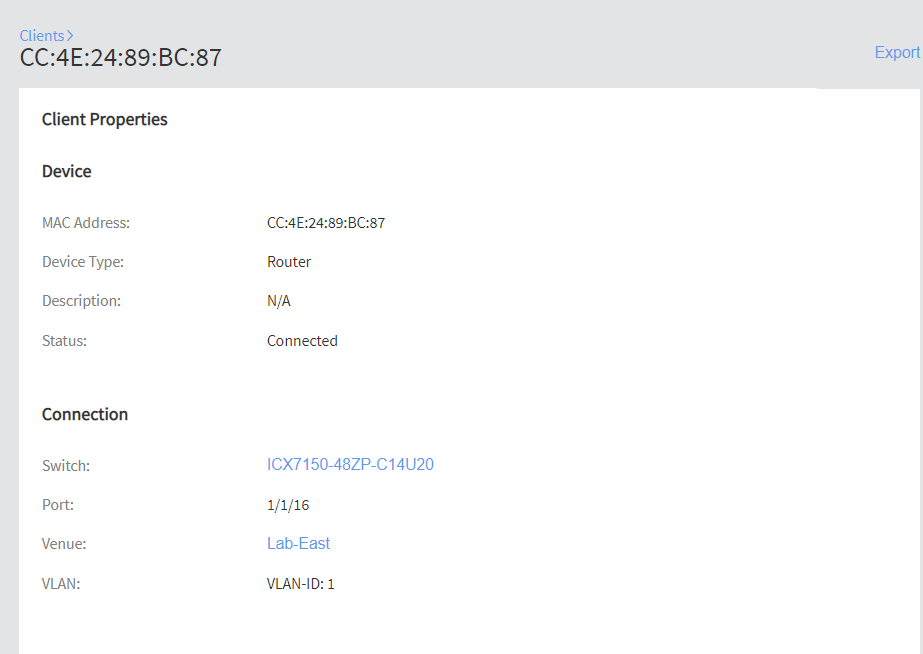Viewing Client Details
You can view details about a wireless client to determine its properties, including its MAC address, IP address, and the user name used to associate it with the AP or switch. You can also view information about its connection, venue, AP or switch, network, and VLAN ID.
Note: References to the name of an object managed by the Ruckus Cloud portal (Venue, AP or switch, Network, Client) display in blue to represent a link to the detail page of the object. For example, the AP name in the Connection section table, links to the AP page.
-
From menu, click
Users.
By default, the Wi-Fitab is selected.The Users page loads and displays th two tab Wi-Fi and Switch. The screen displays both connected and disconnected (historical) wireless clients with search options. When searching for disconnected (historical) clients, you can only search by MAC address, hostname or username.Note: If a large number of clients appears on the Clients page, use the filtering options to narrow down the client list. Refer to Filtering Associated Clients for more information.
-
From the list of currently associated clients, locate the wireless client (connected or disconnected) for which you want to view details, and then click its MAC address.
The Client MAC Address page appears and displays three sections across two panes followed by five report-type sections.
-
In the
Client Properties section, information about the wireless client's network properties information displays.
The following table lists the client property details for connected and disconnected clients:
Table 1. Client Property Details MAC Address MAC address of the wireless client Device OS Operating System icon and name Host Name Product name User Name User name used to associate with wireless client with the managed AP Status Current status of the wireless client -
In the
Connection section, information about the wireless client's connection information displays.
The following table lists the client's current connection details:
For disconnected clients, the connection information displays as a Last Session section with the following details for the disconnected client's last session:Table 2. Client's Current Connection Details Connected Time Length of time that has elapsed since the wireless client associated with the managed AP IP Address IP address assigned to the wireless client AP Name Name of the AP with which the wireless client is associated Venue Venue name where the client is located Network Network name Connected to SSID SSID on the managed AP to which the wireless client is associated VLAN ID ID number of the VLAN Connected to BSSID BSSID on the managed AP to which the wireless client is associated Table 3. Disconnected Client's Last Session Start and End Time Start and end time of the last session of the disconnected wireless client associated with the managed AP Session Duration Duration of the last connected session Last IP Address Last IP address assigned to the wireless client Last AP Connected to Name of the last AP with which the wireless client is associated Last Venue Name of last venue where the client is located Last SSID SSID on the managed AP to which the wireless client is associated -
In the
Operational Data for Current Session section, information about the wireless client's operational data displays.
The following table lists the operational data details for current connected clients ( this information is not available for disconnected clients):
Table 4. Operational Data Details RF Channel Radio Frequency (RF) channel number Transmitted Bytes Number of bytes, in kilobytes, sent during this current session Transmitted Packets Number of packets in total, sent during this current session Received Bytes Number of bytes received during this current session Received Packets Number of packets in total, received during this current session Frames Dropped Number of frames dropped during this current session RSSI The received signal strength indicator, expressed in dBm. The value may be expressed in three colors - green, orange or red. Green represents good signal strength, orange represents moderate signal strength, and red represents poor signal strength. SNR The signal-to-noise ratio, expressed in decibels (dB). The signal power indicator adjacent to the value indicates signal strength. Higher value indicates more power. -
In the
Client Information for Last 7 Days (Date-start-to-date-finish) section you can choose to display the information for 24 hours or 7 days using the drop-down arrow on the right of the screen.
The following report information in table or graphical format is displayed:
- Historical Stats—the following information is displayed for both connected and disconnected clients:
- Number of APs that are connected
- Average rate in Bytes
- User traffic in MB
- Number of applications being used
- Average session length in minutes and seconds
- Number of sessions
- Slider graphic showing use of the radio bands 2.4GHz and 5GHz in Bytes, GB, or MB
- Traffic Trend
- Top 10 Applications by Traffic Volume
- Events History
- Session History
Review the information for any patterns or trends. - Historical Stats—the following information is displayed for both connected and disconnected clients:
Viewing Switch Clients
-
From menu, click
Users.
The Users page loads and displays.
-
Select the
Switch tab.
The switch clients page appears displaying the list of clients with the following information.
- MAC Address: MAC address of the switch client.
- Description: Description about the switch client.
- Device Type: the device type.
- Venue: The name of the venue.
- Switch: the name of the switch.
- Port: The port number of the switch.
- VLAN: The VLAN ID.
-
Click on a switch client to view its properties.
Switch Client Properties 
The switch Client Properties page displays the following information.
Device- MAC Address: MAC address of the switch client.
- Device Type: the device type.
- Description: Description about the switch client.
- Status: The status of the connection.
Connection- Venue: The name of the venue.
- Switch: the name of the switch.
- Port: The port number of the switch.
- VLAN: The VLAN ID.